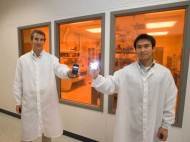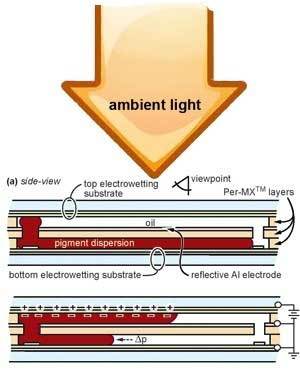New low-power usage displays able to show dynamic content
 A new electro-fluidics design from the University of Cincinnati shows potential to improve the image capabilities of electronic devices. Similarly to the Qualcomm Mirasol display for color e-readers we described earlier, this display is able to display dynamic content while it is consuming low power. Its developers claim it will be able to provide high readability in bright sunlight and the ability to display videos or hold an image indefinitely without electrical power usage.
A new electro-fluidics design from the University of Cincinnati shows potential to improve the image capabilities of electronic devices. Similarly to the Qualcomm Mirasol display for color e-readers we described earlier, this display is able to display dynamic content while it is consuming low power. Its developers claim it will be able to provide high readability in bright sunlight and the ability to display videos or hold an image indefinitely without electrical power usage.
This patent-pending electro-fluidics breakthrough by the Novel Devices Laboratory at the University of Cincinnati and partner companies Gamma Dynamics, Dupont and Sun Chemical follows about seven years of work. According to lead researcher Jason Heikenfeld, UC associate professor of electrical and computer engineering in the College of Engineering & Applied Science, the breakthrough is even more impressive when you realize that similar research efforts elsewhere have lasted a decade without achieving similar results.
The new “zero-power” design requires low-power because it makes use of ambient light instead of a strong, internal light source within the device. Yet, even though an electronic device with this eletrofluidic technology would lack a strong, internal light source, it would still display bright images at high speed. Behind the display screen are two layers of liquid (oil and a pigment dispersion fluid like an inkjet fluid). Between the two layers are reflective electrodes which act as a highly reflective mirror.
Ambient light enters through the display screen and through the first layer of liquid and hits the reflective electrodes. When the light hits that reflective electrode, it bounces back out to the viewer’s eye, creating the perception of a bright, color-saturated image.
A small electric charge powers the movement of the mentioned oil and pigment-dispersion liquids. The movement occurs between a bottom layer behind the reflective electrodes and a top layer in front of the reflective electrodes. When the pigmented substance is positioned in the “top” layer (sandwiched between the ambient light and reflective electrodes), it creates a reflected ray of colored light which combines with literally millions of ambient light rays to produce a full-color display.
The developers of this display are quite confident regarding their inventions and claim that the closest competition with similar brightness is electrochromic technology, which does not switch quickly enough to create video images. And the closest competition that works on low power but can still provide dynamic content is called Quallcomm Mirasol. However, according to the UC researchers, when trying to display a color like white, the Mirasol technology has about one-third the brightness level of the UC technology.
Importantly, the new e-Display design is manufacturable with current facilities and technology. According to John Rudolph, president of Gamma Dynamics, this electro-fluidics breakthrough will change the display technology used in a myriad of electronic devices. He estimated consumers will likely first see it in action as grocery-store shelf labels and advertising displays in about three years’ time.
For more information you can read the paper published in Applied Physics Letters: “High reflectivity electrofluidic pixels with zero-power grayscale operation”.










Leave your response!